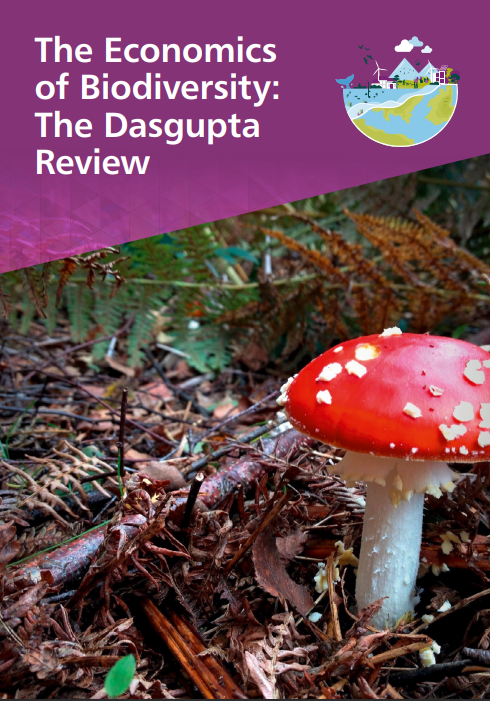The Economics of Biodiversity: The Dasgupta Review, commissioned by the UK government, underscores the importance of biodiversity and the impact of human actions on nature. It argues that the current economic system is unsustainable and calls for urgent action to protect biodiversity for future generations. For instance, the Review found that the loss of biodiversity is a serious threat to human well-being. The annual global cost of biodiversity loss is estimated to be between US$500 and US$2,000 billion. It found that the loss of biodiversity is driven by several factors, including:
- Habitat loss
- Overexploitation
- Pollution
- Climate change
Hence, the report recommends integrating biodiversity into economic decision-making, investing in natural capital, promoting sustainable consumption and production, and advocating for international cooperation and new governance structures to address the global biodiversity crisis.
Moreover, the report found that economic decision-making often does not consider biodiversity’s benefits. This is because biodiversity benefits are often public goods, which are non-excludable and non-rivalrous. Therefore, It is difficult to charge for biodiversity benefits, and one person’s use of a biodiversity benefit does not reduce another person’s ability to use the same benefit.
Still, the Review finds that the value of nature’s contributions to the economy, such as providing food, water, and clean air, is far greater than we currently recognize. These contributions are estimated to be around US$32 trillion annually, more than half of the global economy.
Challenging Current Economic Models
In this sense, Professor Partha Dasgupta contends that our present economic model fails to consider biodiversity’s value, leading to its degradation adequately. He believes this oversight harms humanity and threatens the ecosystems we depend on. He argues that our economy prioritizes immediate profit over long-term sustainability, resulting in the overuse of natural resources. This unsustainable practice harms biodiversity and negatively affects communities reliant on nature.
Undervaluing Biodiversity
The report emphasizes the frequent undervaluing of biodiversity. It criticizes traditional economic measures, like the Gross Domestic Product (GDP). Dasgupta states that GDP overlooks the true value of biodiversity, ignoring its essential role in food security, water purification, and climate regulation. He suggests that this disregard leads to further environmental degradation, with future generations suffering the consequences of lost biodiversity.
The Impact of Biodiversity Loss
It highlights the severe effects of biodiversity loss, demonstrating that extinction is happening at unparalleled rates and could have irreversible impacts on humans. For example, the report cites numerous examples of biodiversity loss, from the decline in pollinators essential for food production to the devastation of coral reefs that protect coastal areas.
Dasgupta stresses that biodiversity loss is not just an environmental concern; it intensifies poverty, threatens human health, and has severe implications for humanity. The loss of ecosystem services, such as clean air and water, can endanger human health, while the depletion of natural resources can cause food shortages and economic instability. However, among the key recommendations to address this, he suggests:
- Redefining GDP: calls for a revised approach to measuring GDP, incorporating the value of biodiversity into the equation. Later, this would provide a more accurate representation of a nation’s wealth and well-being.
- Internalizing Biodiversity Costs: advocates for internalizing the costs of biodiversity loss into market prices, ensuring that those who cause harm to ecosystems bear the financial burden. For example, this could be achieved through pollution taxes or subsidies for sustainable practices.
- Investing in Biodiversity Research and Development: emphasizes the need for increased funding for research and development of technologies aimed at conserving biodiversity. This includes innovations in sustainable agriculture, forestry, and renewable energy.
- Strengthening International Cooperation: underscores the importance of international cooperation in addressing biodiversity loss, calling for enhanced coordination and collaborative efforts among nations.
Report Structure:
Part I – Foundations
- Chapter 1 introduces the biodiversity crisis and calls for action.
- Chapter 2 discusses biodiversity’s economic value and the need for comprehensive economic models.
- Chapter 3 assesses global biodiversity and the impact of human activities.
- Chapter 4 delves into the role of biodiversity in ecosystem functions.
- Chapter 5 examines human actions causing biodiversity loss and the need for sustainable resource use.
- Chapter 6 highlights the costs of biodiversity loss, especially for vulnerable communities.
- Chapter 7 discusses the economic costs and benefits of biodiversity conservation.
- Chapter 8 underscores the economic benefits of conservation, including job creation and sustainable tourism.
- Chapter 9 emphasizes the role of markets and public policies in sustainable development.
- Chapter 10 focuses on policy interventions for biodiversity conservation.
- Chapter 11 explores the role of institutions in sustainable development.
- Chapter 12 discusses the potential and challenges of technology for conservation.
- Chapter 13 examines the ethical dimensions of biodiversity conservation.
Part II – Extensions
- Chapter 14 stresses the importance of culture and its influence on biodiversity conservation.
- Chapter 15 highlights the role of education in promoting sustainability and biodiversity.
- Chapter 16 emphasizes the significance of finance in sustainable development, noting the importance of public, private, and blended finance.
- Chapter 17 discusses businesses’ contribution to sustainability and biodiversity, focusing on sustainable sourcing, green marketing, and corporate social responsibility.
- Chapter 18 underscores the pivotal role of cities in sustainable development, touching on green and blue infrastructure, resource efficiency, and waste reduction.
- Chapter 19 emphasizes agriculture’s impact on biodiversity, exploring sustainable practices like agroforestry and conservation agriculture.
- Chapter 20 stresses the need for international cooperation to address the global biodiversity crisis, suggesting using international agreements and promoting sustainable development.
Part III – The Road Ahead
Finally, Chapter 21 outlines the need for three transitions: aligning human demands with nature’s supply, redefining economic success to include nature’s value, and revamping institutions to facilitate these changes. It underscores the need for a collective global response to the biodiversity crisis.
The Economics of Biodiversity: The Dasgupta Review




